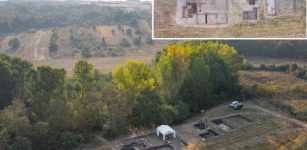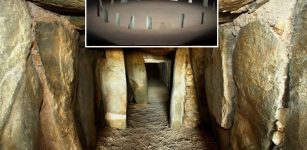4,000-Year-Old Lunar Calendar Developed At Kokino Megalithic Observatory – Evidence Of Remarkable Astronomical Knowledge
Ellen Lloyd - AncientPages.com - All around the world there are magnificent ancient structures that show our ancestors have always been interested in studying the skies. Our interest in the cosmos is as old as humanity. Archaeological discoveries keep reminding us ancient people possessed more astronomical knowledge than previously thought.
Megalithic Observatory Kokino near Kumanovo in Macedonia. Credit: US Government - Public Domain
Several ancient cultures achieved a deep understanding of the celestial movements, cycles of the sun, moon, stars, and planets, and they often used this knowledge to build astronomically oriented temples on the apex of the hills so priests could watch the Sun, the Moon, stars and all planets that could be observed.
There is no doubt fascination with the cosmos was widespread in Egypt, Babylon, Sumer, India, and South America, and we can see proof of this by examining ancient temples, and other sacred structures. However, there is also evidence of ancient less known, yet sophisticated astronomical knowledge in Europe. For example, scientists were stunned when they have discovered the world’s oldest Moon map carved into Ireland’s 5,000-year-old tomb at Knowth.
Equally impressive are the carved-engraved bone plates discovered in France have revealed people created astonishing lunar and solar calendars 30,000 B.C. When and where people started to study the heavens and celestial objects is impossible to say, but if we turn our attention to Europe, we discover extraordinary astronomical knowledge that shows celestial objects were of great importance to our ancestors.
In the Republic of Macedonia, there is an interesting Bronze Age site known as Kokino. Despite being so old, the site was first discovered in 2001 by archeologist Jovica Stankovski.
Locals were most likely familiar with this historical place long before, but the outside world learned about the site only recently.
What makes this particular place so special are the archaeoastronomical characteristics of the megalithic observatory Kokino that is located approximately 30 km from the town of Kumanovo, and about 6 km from the Serbian border, in the Staro Nagoričane municipality.
Scientists have discovered giant stones arranged in puzzling patterns that offer evidence Kokino was used by people as far back as 4,000 years ago.
Kokino is on the foot of a mountain peak, at an elevation of over 3,300 feet. While examining the site scientists found that “on the west side or in on the lower platform of the site there are three specifically crafted observation posts from where the ancient observers continuously monitored the Sun and Moon’s movement. On an about 50 to 85 m distance, in the rocks on the east horizon, which are also placed on the upper platform of the site, there are specially crafted markers, marking the places of the Sun rise and full Moon rise in exactly determined and characteristics days.” 1
Like many other ancient civilizations, people in the Balkans were interested in the Full Moon that is related to numerous ancient myths and legends and even paranormal tales.
Kokino Megalithic Observatory. Credit: Darko Nikolovski - CC BY-SA 3.0
The studies of the Moon at the megalithic Kokino observatory led to the development of a lunar calendar that people used to determine “the moment of switch between the summer and winter and the beginning of the New Year. As in all other cases, the lunar calendar that was developed and used on the megalithic Observatory Kokino had 19 lunar years’ cycle.
About 4,000 years ago people in Macedonia studied the moon and created sophisticated lunar calendars. Credit: Orion 8 - CC BY-SA 3.0
Regular lunar years had a length of 354 days and consisted of 6 lunar months with 29 days and six lunar months with 30 days length. Seven lunar years had thirteen lunar months, due to the fact that according to previously determined scheme one lunar month with 30 days was added. The method of development of the lunar calendar can be demonstrated even today by monitoring the full Moon rise.” 1
The megalithic Kokino observatory adds to the lists of ancient sites demonstrating our ancestors’ profound knowledge of astronomy, and we can once again say ancient people were much more advanced than previously thought. The fact that the method used to develop the lunar calendar at this site 4,000 years ago is still correct is an incredible ancient achievement.
Written by Ellen Lloyd – AncientPages.com
Copyright © AncientPages.com All rights reserved. This material may not be published, broadcast, rewritten or redistributed in whole or part without the express written permission of AncientPages.com
Expand for references- Cenev, G - Three Worlds of the Megalithic Observatory Kokino, Journal: The Inspiration of Astronomical Phenomena VI.
More From Ancient Pages
-
 8,000-Year-Old House Remains Discovered In Svinjarička Čuka, Serbia Raise Questions About Europe’s First Farmers
Archaeology | Oct 21, 2024
8,000-Year-Old House Remains Discovered In Svinjarička Čuka, Serbia Raise Questions About Europe’s First Farmers
Archaeology | Oct 21, 2024 -
 Adad ‘Lord Of Abundance’- Mesopotamian Weather God Who Was Responsible For Fertility, Wealth And Oracles
Featured Stories | Mar 11, 2020
Adad ‘Lord Of Abundance’- Mesopotamian Weather God Who Was Responsible For Fertility, Wealth And Oracles
Featured Stories | Mar 11, 2020 -
 Evidence For Milk, Meat, And Plants In Prehistoric Kenya And Tanzania
Archaeology | Apr 15, 2020
Evidence For Milk, Meat, And Plants In Prehistoric Kenya And Tanzania
Archaeology | Apr 15, 2020 -
 Ancient Mysteries Of The Amazon Jungle – Survivors Of The Great Flood Or An Atlantean Race Hidden In The Forest? – Part 2
Ancient Mysteries | May 29, 2018
Ancient Mysteries Of The Amazon Jungle – Survivors Of The Great Flood Or An Atlantean Race Hidden In The Forest? – Part 2
Ancient Mysteries | May 29, 2018 -
 Magnificent Ancient Artifacts Found In Bulgaria Last Year Go On Display
Archaeology | Feb 14, 2023
Magnificent Ancient Artifacts Found In Bulgaria Last Year Go On Display
Archaeology | Feb 14, 2023 -
 On This Day In History: Battle Of Lagos Took Place Between Royal Navy Of Britain and France – On August 19, 1759
News | Aug 19, 2016
On This Day In History: Battle Of Lagos Took Place Between Royal Navy Of Britain and France – On August 19, 1759
News | Aug 19, 2016 -
 Ancient Egyptian Toys And Games In Focus
Featured Stories | Jan 15, 2016
Ancient Egyptian Toys And Games In Focus
Featured Stories | Jan 15, 2016 -
 Dolmen de Soto: Unique Millennia-Old Underground Structure Remains A Puzzling Enigma
Featured Stories | Feb 10, 2022
Dolmen de Soto: Unique Millennia-Old Underground Structure Remains A Puzzling Enigma
Featured Stories | Feb 10, 2022 -
 Legendary ‘Orichalcum Metal’ Related To Atlantis Found In 2,600-Year-Old Shipwreck
Archaeology | Mar 3, 2017
Legendary ‘Orichalcum Metal’ Related To Atlantis Found In 2,600-Year-Old Shipwreck
Archaeology | Mar 3, 2017 -
 Baalbek: Were The Megaliths Put In Place Under Herod?
Archaeology | May 27, 2019
Baalbek: Were The Megaliths Put In Place Under Herod?
Archaeology | May 27, 2019 -
 Mysterious Ancient Giant Jars Made By An Unknown Civilization Discovered In India
Archaeology | Mar 30, 2022
Mysterious Ancient Giant Jars Made By An Unknown Civilization Discovered In India
Archaeology | Mar 30, 2022 -
 Venus Cloacina: Roman Goddess Of Sewers And Drains
Featured Stories | Dec 19, 2019
Venus Cloacina: Roman Goddess Of Sewers And Drains
Featured Stories | Dec 19, 2019 -
 Ancient Trade Routes Between Iran And Mesopotamia – Uncovered
Archaeology | Dec 4, 2015
Ancient Trade Routes Between Iran And Mesopotamia – Uncovered
Archaeology | Dec 4, 2015 -
 Has The Viking Ship Burial Of King Bjørn Farmann Been Found At Jarlsberg Manor, Norway?
Archaeology | Jul 2, 2024
Has The Viking Ship Burial Of King Bjørn Farmann Been Found At Jarlsberg Manor, Norway?
Archaeology | Jul 2, 2024 -
 Native American Population Does Not Originate In Japan – Genetics And Skeletal Biology Questioned
Archaeology | Nov 15, 2021
Native American Population Does Not Originate In Japan – Genetics And Skeletal Biology Questioned
Archaeology | Nov 15, 2021 -
 How Did These Five Common Words Enter The English Language?
Linguistic Discoveries | Oct 28, 2024
How Did These Five Common Words Enter The English Language?
Linguistic Discoveries | Oct 28, 2024 -
 On This Day In History: King Charles II Is Restored To The Throne Of England, Scotland And Ireland – On May 29, 1660
News | May 29, 2016
On This Day In History: King Charles II Is Restored To The Throne Of England, Scotland And Ireland – On May 29, 1660
News | May 29, 2016 -
 4,000-Year-Old Babylonian Tablets Finally Deciphered, Revealing Dangerous Future Predictions
Archaeology | Aug 14, 2024
4,000-Year-Old Babylonian Tablets Finally Deciphered, Revealing Dangerous Future Predictions
Archaeology | Aug 14, 2024 -
 Mysterious Hyksos People Rose To Power In Ancient Egypt Through Marriage And Not Invasion – Researchers Say
Archaeology | Apr 17, 2019
Mysterious Hyksos People Rose To Power In Ancient Egypt Through Marriage And Not Invasion – Researchers Say
Archaeology | Apr 17, 2019 -
 Mysterious Tunnel Found Under Saxon Palace Ruins In Warsaw, Poland
Archaeology | Sep 14, 2023
Mysterious Tunnel Found Under Saxon Palace Ruins In Warsaw, Poland
Archaeology | Sep 14, 2023




